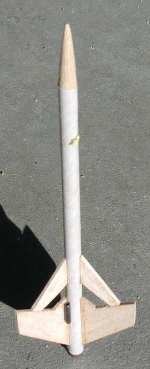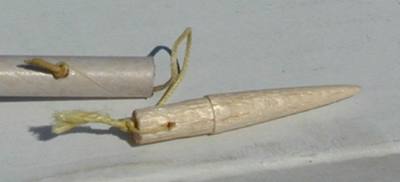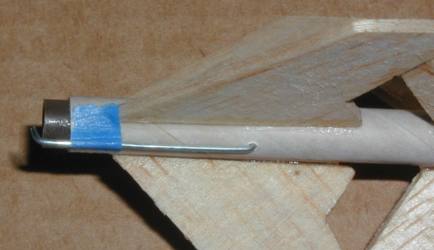Nano Rocketry Interdimensional Transfer Ship
Nano Rocketry Interdimensional Transfer Ship
Contributed by Nick Esselman
| Construction Rating: | starstarstarstar_borderstar_border |
| Flight Rating: | starstarstarstarstar_border |
| Overall Rating: | starstarstarstar_borderstar_border |
At NARAM-43 I purchased a couple of Nano Rockets. Along with the Cougar, I purchased the Interdimensional Transfer Starship (ITS). My kit was apparently updated when compared the earlier submitted review below. My ITS was also, in my opinion, a later-than-Cougar-addition to the Nano fleet as the instructions were improved and there were other nice build features which I will describe below. I bought it because it was one of the most futuristic kits in the Nano fleet.

 The kit comes with a Kevlar shock cord, six (6) laser-cut balsa fins, a 6½" body tube, a wood nose cone, and two (2) brass launch lugs. The instructions are on a single 9x11" sheet of paper and the whole thing is packaged in a 9x6" envelope.
The kit comes with a Kevlar shock cord, six (6) laser-cut balsa fins, a 6½" body tube, a wood nose cone, and two (2) brass launch lugs. The instructions are on a single 9x11" sheet of paper and the whole thing is packaged in a 9x6" envelope.
CONSTRUCTION:
The instructions feature a nice looking title page informing you of the name, skill level (ITS is a level 2) and the maximum altitude expected (~150 feet) and a few nice 3D renderings of the rocket. Once inside you get a bit of a story about the ITS and a warning not to fly it "during natural electrical activity" so that your don't activate the "Dimensional Drives". Also you'll find a list of components, needed supplies, a template for fin assembly and alignment and the marked position of CP and CG. Then there are the steps for construction.
Also included in the instructions are flying details. These describe the removal of the yellow paint from the Quest rod, also utilizing a "Z" bend (which has been a great tip for me), and how to tape the motor into place for flight.
Construction is indeed straightforward with the major challenge being the attachment of the shock cord. I didn't even try the method outlined this time after being frustrated during the construction of the Cougar. I simply did the same as the I did on the Cougar as you will see below.
In step 1, the fins are assembled and the laser-cut fins are easy to work with and the template is good. I used CA and was successful with alignment on two of the three fins, but a simple cut with my hobby knife allowed me to redo that one and be on my way.
 In step 2, the instructions indicate that you are to glue the Kevlar shock cord into the hole in the nose cone. My nose cone did not have a hole, and so I created my own connection by drilling a 1mm hole through the shoulder, grooved it horizontally and then tied the shock cord through the hole.
In step 2, the instructions indicate that you are to glue the Kevlar shock cord into the hole in the nose cone. My nose cone did not have a hole, and so I created my own connection by drilling a 1mm hole through the shoulder, grooved it horizontally and then tied the shock cord through the hole.
The step 3 is the attachment of the shock cord to the body tube. As mentioned above I repeated what I did on the Cougar and drilled a small hole in the side of the body tube, fed the remaining end of Kevlar through it and knotted it. Note: the picture is from my Cougar construction, but is looks the same for the ITS.
 In step 4, the fins are attached and as stated there is an alignment guide to assist in this. You must also reference the drawing to determine how high up from the bottom to glue them. Also in step 4, the launch lug is glued on. As with the Cougar, the launch lug supplied was not the correct diameter for the standard MicroMaxx rod. I found a great solution though...at local hardware stores, look for Tension Pins. I purchased the 3/32" x 1/2" version and it worked great!
In step 4, the fins are attached and as stated there is an alignment guide to assist in this. You must also reference the drawing to determine how high up from the bottom to glue them. Also in step 4, the launch lug is glued on. As with the Cougar, the launch lug supplied was not the correct diameter for the standard MicroMaxx rod. I found a great solution though...at local hardware stores, look for Tension Pins. I purchased the 3/32" x 1/2" version and it worked great!
The instructions are good, needing only minor clean up with editing and spell checking, but much improved compared to the Cougar. And again, the most challenging is the shock cord attachment. The reviewer below seemed to get it to work and I'm sure Nano has had success, but this is an area that could use some continued focus. Alternately, the instructions might want to describe the "hole in the side" method too.
I didn't paint my rocket, but the instructions emphasized "light" finishing. Although, now that I have flown the ITS a few times, I'm thinking about attempting to finish it in some way.
Overall, for CONSTRUCTION I would rate this kit 3 points. The nose cone did not fit the instructions description, the shock cord mounting method is too challenging and the launch lugs did not fit the standard Quest rail. However, these are all the same as on the Cougar and Nano tells me that they have nose cones that meet the description shipping in the kits now, that they are working on a shock cord mounting method, and that they are looking for new lugs. Apparently the lugs fit some older Quest rails. The parts quality are good and the instructions are adequate.
FLIGHT/RECOVERY:
I have flown the ITS four (4) times and right out of the shoot it has performed well.
My first flight came off the pad fine and went to about 100 feet. ( I use my house height as a gauge and it went about 3x the height). Then ejected, while still going up, and landed on my roof. Recovered.
The second flight was another successful flight and recovered in the nearby grass. I did notice that even though the nose cone ejected is still fell with authority and was stable with the top of the body tube leading the way.
 For the third and fourth flights, I implemented a motor thrust-retainer. This was made from a small paper clip that was bent and cut to size. It is held in place with a small piece of tape. The important thing to remember is that the length of the clip needs to be just a hair longer than the motor. Not a lot longer or you'll have trouble getting it set up on the ignitor. Also the part that will hold the motor in upon ejection needs to be just long enough to catch the lip of the motor. Pictured here, mine is slightly too long because it interfered with the ignitor. Even with my motor hook, my CG is where the instructions say it should be.
For the third and fourth flights, I implemented a motor thrust-retainer. This was made from a small paper clip that was bent and cut to size. It is held in place with a small piece of tape. The important thing to remember is that the length of the clip needs to be just a hair longer than the motor. Not a lot longer or you'll have trouble getting it set up on the ignitor. Also the part that will hold the motor in upon ejection needs to be just long enough to catch the lip of the motor. Pictured here, mine is slightly too long because it interfered with the ignitor. Even with my motor hook, my CG is where the instructions say it should be.
Both the third and fourth flights were successful with the motor thrust-retainer and I didn't see an altitude difference.
For FLIGHT/RECOVERY, I would rate this kit 4 points. The ITS flew well and was stable. It can't be perfect because of the friction fit of the motors and it is a bit too stable coming down without the nose cone.
Overall, the ITS flew as good as Quest's best pre-built rockets (Raw Fusion and Vector). It is "futuristic" looking and has enough size to make it enjoyable to watch fly. I would recommend this one to others, hoping that Nano at least addresses the launch lug problem. I give the kit an OVERALL rating of 3 points.
Sponsored Ads
 |
 |











